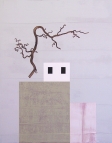House / Home

In the 1930s both Sergei Eisenstein and Walter Benjamin identified and elaborated formal and phenomenological correspondences between cinema and architecture. This essay takes their generative speculative comparisons of these distinct art forms as a framework for analyzing and understanding some of the stylistic qualities of Amos Gitai’s 1980 documentary House.
Over a period of twenty-seven years (1978–2005), Amos Gitai directed a trilogy dealing with the cultural, political, and social consequences of the renovation and redesign of the same house located in Jerusalem. We consider intermediality an interesting way of looking at this corpus of nonfiction films. This way of thinking offers a framework to help us come to terms with the conditions of the possibility of living a shared experience. The purpose of this paper is to explore this trilogy as an intermedial milieu. We seek to understand: What sets this milieu in motion? What mediations are staged by Gitai in these three films? The study of the trilogy itself and of the “blockages” that we see taking shape in it led us to use another expression than “living together” that could render conceptually the limits and frictions staged in the films. The term “co-existence” seems to us to be more appropriate to account for the aspects evoked by Gitai in the Bait trilogy.
This article discusses and compares Amos Oz’s Po va-sham be-eretz Israel (In the Land of Israel) and Amos Gitai’s Yoman sade (Field Diary), which bring an extensive exploration of the Land of Israel just before and during the initial phases of the First Lebanon war in 1982. As a major author of Israeli literature and as a talented “auteur” in Israeli cinema, Amos Oz and Amos Gitai listened to and observed Israelis, settlers, and Palestinians and filed their reports with their audiences. This article highlights their similarities as authors, as well as their differences in perspectives on the Israeli space and nationality, the notions of house, home, and homeland.
Israeli memory culture has evolved in recent decades, from the more openly critical voices of the New Historians in the 1990s — which viewed history as something that could be revised, even corrected, with the introduction of new information and perspectives — to the more recent, postmodern view that any appreciation of the past may always remain flawed and partial at best. Israeli cultural expression has been shaped, in turn, by this evolving sense of the past in relation to both collective and personal memory. Two examples in this essay serve as tethers for how this process has evolved. Both Amos Gitai’s film trilogy House and Rutu Modan’s graphic novel Tunnels engage what I call “the archaeological imagination,” a mode of artistic exploration in which the tensions between surface and depth, between the present and the past, affect formal structures in each work.
Using Haim Gouri’s 1960 poem “I am Civil War” as its departure point, this essay aims to offer a historically anchored reading of Gouri’s “poetics of concealment” — a playful, purposeful use of poiesis as a means to disguise uncomfortable truths and as a mode of “aphasia,” blocking historical knowledge. The argument unfolds through several stages. After looking at Gouri’s early career and the unresolved tension between Gouri the “reporter” and Gouri the “witness,” the essay reassesses the transition we see in his poetry from an earlier collectivist “we” to a new, seemingly personal “I.” From there, it looks at the highly charged term milḥemet ezraḥim (civil war) in Hebrew and its uses before Gouri appropriated it. Lastly, it revisits a sensitive episode in Gouri’s early biography, connected to his role during the Saison, and his avoidance of “confession,” which sheds light on the way Gouri metaphorized and internalized the notion of civil war, turning it into an inner struggle and personal dilemma.
This essay explores the representations of the Israeli home in the writings of the prominent Israeli writer S. Yizhar (Yizhar Smilansky, 1916–2006). Although the concept of the new Jewish home as the symbol of the Zionist metamorphosis is a major theme in Hebrew literature, Yizhar’s fiction contains few descriptions of houses and people’s homes, and he remains detached from, and skeptical about, this rhetoric and ideology. A sense of “uncanny strangeness” (Kristeva), which undermines the very idea of homecoming, imbues his rare, yet highly significant images of the home. This essay investigates Yizhar’s magnum opus Yemei Ziklag (1958) in conjunction with his autobiographical novel Mikdamot (1992), both of which present detailed descriptions of Jewish and Arab houses, portraying their material and symbolic instability and the threat they embody, thus associating unhomeliness with the problematics of Jewish-Arab coexistence. The essay points to Yemei Ziklag’s intertext, the story of King David’s escape to the city of Ziklag, with its own figure of the instability of the home, as the primal scene in a chain of Yizharian depictions of homelessness, at the core of which lies the recognition that no home is safe and that today’s home may well become tomorrow’s ruin (and vice versa).
Issues
Editorial Board
Vered Karti Shemtov, Dibur Editor-in-Chief
Yotam Popliker, Dibur Executive Editor
Chen Bar-Itzhak, Dibur Editor
Chen Edelsburg, Dibur Curated Editor
Contact Us
Email:
diburlitj@gmail.com
Dibur Supporters
Dibur is made possible by grants from:
- Stuart R. Epstein, California
- The Taube Center for Jewish Studies
- Center for Comparative Studies in Race and Ethnicity, Religious Studies
- Jewish Community Federation's Newhouse Fund
- The School of Humanities and Sciences, Stanford University



